Lockdown is the perfect time to take stock of the wildlife on your doorstep. Even if you haven’t got a garden of your own, you are never far from a potential wildlife encounter. Kate Bartram, our East Cleveland Heritage Officer, took this opportunity to explore her gardens’ marvellous moths. Armed with a heath trap, which uses a light source to attract moths coming out at night, she set about monitoring and releasing over 100 individual species (of the amazing 2500+ moth species in Great Britain).
I’m an absolute beginner to moth trapping and identification. So, to get me started I asked for some guidance from our County Moth Recorder, Robert Woods. He suggested two reference books and to check out the website What’s flying tonight? for useful guides and resources. These have proven invaluable. With a moth trap borrowed from work, I was all set.
Not bad for a first-timer
On my first night, I caught five moths from three different species. I was a little disappointed not to have more, but this was only the first night. In any case, I was able to gently lift the moths from the trap and have a closer look. They are quite calm in the cool of the morning and not too likely to fly away. I also took some photographs to remind me later what they looked like and help with identification. I also wanted to keep a moth diary to see if the nighttime conditions made any difference to the species I would see in the morning.
The diversity of marvellous moths in my little suburban garden was staggering. Between April and September, I logged a fantastic 109 different species. Only a few thousand more to go!
If you’re interested in recording your moths or want more information, visit Butterfly Conservation.
You can read the full story in the Winter Issue of Wild Tees Magazine. Become a member and you will receive your issue of Wild Tees Magazine and much more. Hit that ‘Join’ button at the top of the page!




